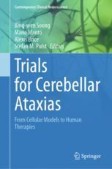Search
Search Results
-
Cerebellar tDCS as Therapy for Cerebellar Ataxias
In recent years, a growing body of literature has investigated the use of non-invasive brain stimulation (NIBS) techniques to influence cerebellar...
-
Patient-Related Outcome Measures for Oculomotor Symptoms in the Cerebellar Ataxias: Insights from Non-Cerebellar Disorders
In patients with cerebellar ataxia (CA), symptoms related to oculomotor dysfunction significantly affect quality of life (QoL). This study aimed to...

-
Milestones in genetics of cerebellar ataxias
Cerebellar ataxias (CAs) comprise a group of rare, neurological disorders characterized by extensive phenotypic and genetic heterogeneity. The core...
-
Iron Pathophysiology in Friedreich’s Ataxia
Friedreich’s ataxia (FRDA) is a degenerative disease that affects both the central and the peripheral nervous systems and non-neural tissues...
-
Inherited Cerebellar Ataxias: 5-Year Experience of the Irish National Ataxia Clinic
Establishing a molecular diagnosis in patients with progressive ataxia is often challenging due to significant genetic and clinical heterogeneity and...

-
Blood and CSF Biomarkers in Autosomal Dominant Cerebellar Ataxias
A biomarker can be defined as a measurable indicator of the presence or severity of a disease state, often present before clinical signs are evident....
-
Rescuers from the Other Shore: Intercellular Mitochondrial Transfer and Its Implications in Central Nervous System Injury and Diseases
As the powerhouse and core of cellular metabolism and survival, mitochondria are the essential organelle in mammalian cells and maintain cellular...

-
MR Spectroscopy in Health and Disease
Magnetic resonance spectroscopy (MRS) enables the noninvasive quantification of up to 20 neurochemicals in selected brain regions and has found many...
-
Impaired antioxidant KEAP1-NRF2 system in amyotrophic lateral sclerosis: NRF2 activation as a potential therapeutic strategy
BackgroundOxidative stress (OS) is an imbalance between oxidant and antioxidant species and, together with other numerous pathological mechanisms,...

-
A first description of ataxia with vitamin E deficiency associated with MT-TG gene mutation
Ataxia with isolated vitamin E deficiency (AVED) is a rare autosomal recessive cerebellar ataxia disorder that is caused by a mutation in the...

-
Genetic spectrum and clinical features in a cohort of Chinese patients with autosomal recessive cerebellar ataxias
BackgroundAlthough many causative genes have been uncovered in recent years, genetic diagnosis is still missing for approximately 50% of autosomal...

-
Endocrine Disorders
This chapter discusses the links between hormonal disorders and cerebellar symptoms. Cerebellar development depends on thyroid hormone (TH) which...
-
Feasibility and Acceptability of Lee Silverman Voice Treatment in Progressive Ataxias
Communication difficulties have considerable impact on people with progressive ataxia, yet there are currently no evidence-based treatments. LSVT...

-
MicroRNAs in Neurodegenerative Diseases
MicroRNAs (miRNAs) represent the first and most prominent group of abundant small non-coding RNA molecules discovered to interfere with gene...
-
Automated functional upper limb evaluation of patients with Friedreich ataxia using serious games rehabilitation exercises
BackgroundFriedreich ataxia (FRDA) is a disease with neurological and systemic involvement. Clinical assessment tools commonly used for FRDA become...

-
Prevalence of Fragile X-Associated Tremor/Ataxia Syndrome in Patients with Cerebellar Ataxia in Japan
The presence of fragile X mental retardation 1 ( FMR1 ) premutation has been linked to patients with a certain type of cerebellar ataxia, the fragile...

-
Multimodal Mobility Assessment Predicts Fall Frequency and Severity in Cerebellar Ataxia
This cohort study aims to evaluate the predictive validity of multimodal clinical assessment and quantitative measures of in- and off-laboratory...

-
An update on the neurological short tandem repeat expansion disorders and the emergence of long-read sequencing diagnostics
BackgroundShort tandem repeat (STR) expansion disorders are an important cause of human neurological disease. They have an established role in more...

-
Widening the clinical, radiological and genetic spectrum of autosomal recessive ataxia of Charlevoix-Saguenay in Indian patients
BackgroundAutosomal recessive spastic ataxia of Charlevoix-Saguenay (ARSACS), classically presenting as a triad of early-onset cerebellar ataxia,...

-
Identifying unstable CNG repeat loci in the human genome: a heuristic approach and implications for neurological disorders
Tandem nucleotide repeat (TNR) expansions, particularly the CNG nucleotide configuration, are associated with a variety of neurodegenerative...

